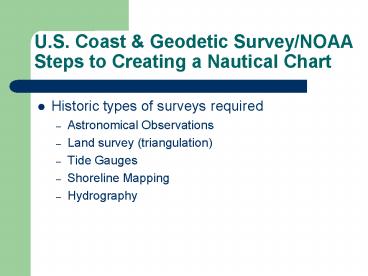U.S. Coast - PowerPoint PPT Presentation
Title:
U.S. Coast
Description:
U.S. Coast & Geodetic Survey/NOAA Steps to Creating a Nautical Chart Historic types of surveys required Astronomical Observations Land survey (triangulation) – PowerPoint PPT presentation
Number of Views:100
Avg rating:3.0/5.0
Title: U.S. Coast
1
U.S. Coast Geodetic Survey/NOAASteps to
Creating a Nautical Chart
- Historic types of surveys required
- Astronomical Observations
- Land survey (triangulation)
- Tide Gauges
- Shoreline Mapping
- Hydrography
2
Theodolite instrument for precise astronomical
observations to determine latitude, longitude,
and azimuth
Astronomical observations were necessary to
determine the position and orientation of
selected points in a survey network.
3
View through Telescope at desired star
Star aligned with cross-hair
4
Survey Network
Astromical Observations performed at this site to
determine initial latitude, longitude, and
azimuth.
5
TRIANGULATION
Angle measured
Angle measured
survey mark
MEASURED BASELINE 1
Angle measured
Angle measured
MEASURED BASELINE 2
STEPS
- Baselines (BL) 1 2 are measured
- All angles of the triangles are measured
- Sides of all triangles are computed
- Computed length BL2 is compared to measured
length of BL2
6
TIDE GAUGES
- Tide zone boundaries shown in red and orange
- Within each zone tidal height and time
correctors are equal - Tidal data required to correct depths and to
determine horizontal position of shoreline
7
- Plane table is set-up over known point
- Paper map correctly oriented
- Distant objects sighted upon and lines drawn from
present position toward distant objects
- Plane table moved to another location and
procedure repeated - Points of intersection define position of distant
objects - Shoreline is drawn through intersecting points
also range bearing determine positions
8
PLANE TABLE MAPPING
9
Depths (soundings) are measured continuously
along dotted lines. Sextant angle fixes are taken
at locations indicated by green bars.
6
7.2
9.1
9.5
5.1
7
7.9
9.3
9.4
6.1
8
5.7
8.5
7
6.5
8.9
7.8
5
8
9
7
5.2
9.2
6
9.2
5.5
7.1
9.5
8
10
HYDROGRAPHY
- Two sextant angles at periodic points along the
launchs path determine position of the launch
11
GEODETIC SURVEY
SHORELINE SURVEY
TIDAL SURVEY
HYDROGRAPHIC FIELD SHEET
FINISHED NAUTICAL CHART































